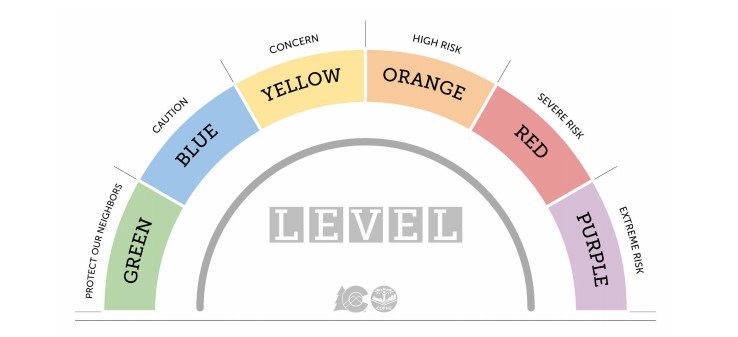Editor's note: This story was originally published by Colorado Newsline and was supplemented with Boulder County information. Read the original story here.
Soon, Colorado’s COVID-19 dial is getting a makeover.
State health officials determine county-level coronavirus restrictions based on various disease metrics included in the COVID-19 dial framework, which they first rolled out in September.
The latest iteration of the dial includes six levels, ranging from green (“Protect Our Neighbors”) to purple (“Extreme Risk”). Levels are, at least in theory, determined by the rate of new COVID-19 infections, the test positivity rate, and the rate of new hospitalizations in a given county. As of Monday, most counties were somewhere in the middle of the dial, in yellow (“Concern”) or orange (“High Risk”). Boulder County was at orange.
Each level comes with its own restrictions in such categories as restaurant capacity, personal gatherings and the time of last call for alcohol.
Now, after seeking feedback from mayors, city managers, county commissioners and local public health agencies, the Colorado Department of Public Health and Environment is preparing to implement major changes to the COVID-19 dial system. Officials hope the changes will make the dial system more responsive to communities’ needs and help boost local economies by taking advantage of the benefits of COVID-19 vaccination for the most vulnerable.
The proposed changes will be “implemented shortly,” Gov. Jared Polis said in an interview. “But then as more and more people get vaccinated, there’ll likely be another update, and then finally the dial will be abolished, as soon as we’ve reached a level of vaccine immunity that protects the general population.”
Especially as more people 70 and older — those most at risk of severe symptoms of COVID-19 — receive the vaccine, state officials reason there’s less of a chance hospitals will again become overwhelmed, and therefore not as much need for severe restrictions on economic activity. Around 39% of Coloradans 70 and older have received the vaccine, Colorado National Guard Brig. Gen. Scott Sherman said at a Monday news conference.
• Raising the case rate threshold that would force a county to implement mitigation measures, like curfews, or move to a more restrictive dial level. This change would mean many counties would get to move to less restrictive levels.
For example, the yellow-level incidence rate would change from 100 to 175 new cases per 100,000 people over two weeks, to 100 to 300 new cases per 100,000 people over one week. Jefferson County — which is now in the orange level — would be one of the many counties able to move to yellow, since it’s reported 284 new cases per 100,000 people in the last two weeks. This would mean restaurants and gyms could double their indoor capacity from 25% to 50% of normal.
• Measuring the rate of new cases every week, instead of every two weeks, so the state can “more quickly respond to local conditions.”
• Requiring a lower test positivity rate for the yellow and orange levels, which means some counties may have to increase testing before they can qualify for a less restrictive level.
• Adding special consideration for counties with fewer than 20,000 people, since just a few new cases could increase their incidence rate per 100,000 people enough to move them across levels of the dial.
“I’m hopeful that … the new dial system really takes into account a lot of the actual data from the last few weeks and months,” Polis said. “We hope that this hits a little closer to the mark, and we’ll look forward to continuing to work to keep Coloradans safe while keeping our economy open.”
The proposed changes to the state's COVID dial will be among the topics discussed Wednesday at Boulder County Public Health's COVID Community Update.
Join us for our COVID Community Update Wednesday at 3:30 pm. It will feature status of COVID-19 response in the county, info on the new vaccination Phases (priorities), proposed changes to the state Dial & vaccine plans for schools. More info & links: https://t.co/U4MEkDg6xA. pic.twitter.com/XHGKL4iUVi
— Bo Co Public Health (@bouldercohealth) February 1, 2021
Over the past few weeks, coronavirus transmission in Colorado has slowed overall.
“We had a little bit of a holiday spike that followed Christmas and New Year’s, but since that time, we really have been steadily declining,” Dr. Rachel Herlihy, the state epidemiologist, said during the Feb. 1 news conference. “If you look at the slope of the curve that we’ve been seeing the last couple of days, you can see that we’re decreasing a little bit more slowly than we had been in November, but certainly we do continue to see a decrease here in Colorado.”
As of Monday afternoon, 17,376 Boulder County residents had tested positive or were considered probable for COVID, 467 county residents were hospitalized and 232 people had died with COVID, according to Boulder County Public Health.
Public health officials have said that vaccines won’t have a significant effect on reducing COVID-19 cases, hospitalizations and deaths for several months — for now, wearing masks and avoiding social gatherings is more effective at slowing the spread.
Around 8.1% of Colorado’s population had received at least one dose of either the vaccine developed by Pfizer and BioNTech or the vaccine developed by Moderna as of Sunday. Meanwhile, 2.3% of Coloradans had received the two doses required for full protection against COVID-19.
As of Monday afternoon, 21,505 Boulder County residents had received the first dose of the vaccine, and 7,097 had received the full course, according to Boulder County Public Health.
COVID data
For information on Boulder County COVID cases, deaths, hospitalizations and trends, click here.
Colorado Newsline is part of States Newsroom, a network of news outlets supported by grants and a coalition of donors as a 501c(3) public charity. Colorado Newsline maintains editorial independence. Contact Editor Quentin Young for questions: [email protected]. Follow Colorado Newsline on Facebook and Twitter.



